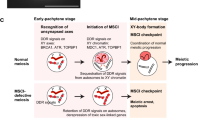Abstract
We have determined the number and location of the nucleolar organizing regions in spermatocytes ofGraphosoma italicum (2n=12A+ XY♂/XX♀) by means of silver impregnation, chromomycin A3/distamycin A staining and fluorescencein situ hybridization. The identification of only one nucleolar organizing region located at one of the X chromosome ends has provided a suitable cytological marker to analyse the segregation of this univalent and that of the XY pseudobivalent during the first and second meiotic divisions respectively. Our results clearly show that at first meiotic metaphase the chromatids of the X chromosome are orientated with their long axes perpendicular to the polar axis. Although the kinetic activity is restricted to only one end in both X chromatids during the first meiotic division, both ends of the same chromatid have the same probability of showing such kinetic activity. In this sense, we also report that the chromatid segregation maybe initiated either at the same sister chromatid ends or at opposite ends in each chromatid. Thus, this indicates a sex chromatid independence as regards to the chromatid segregation during the first meiotic division. Throughout the second meiotic division both ends of the X chromatid are involved with the same probability in the end-to-end association to conform the XY pseudobivalent. This also implies a random localization of the kinetic activity at the ends opposite to those involved in the end-to-end association.
Similar content being viewed by others
References
Albertson DG, Thomson JN (1993) Segregation of holocentric chromosomes at meiosis in the nematodeCaenorhabditis elegans.Chromosome Res 1: 15–26.
Back E, Müller F, Tobler H (1984) Structural organization of the two main rDNA size classes ofAscaris lumbricoides.Nucleic Acids Res 12: 1313–1332.
Camacho JPM, Belda J, Cabrero J (1985) Meiotic behaviour of the holocentric chromosomes ofNezara viridula (Insecta, Heteroptera) analyzed by C-banding and silver impregnation.Can. J Genet Cytol 27: 490–497.
Comings DE, Okada TA (1972) Holocentric chromosomes inOncopeltus: kinetochore plates are present in mitosis and absent in meiosis.Chromosoma 37: 177–192.
Goday C, Pimpinelli S (1989) Centromere organization in meiotic chromosomes ofParascaris univalens.Chromosoma 98: 160–166.
Godward MBE (1985) The kinetochore.Int Rev Cytol 94: 77–104.
Hughes-Schrader S, Schrader F (1961) The kinetochore of the Hemiptera.Chromosoma 12: 327–350.
Nokkala S (1985) Restriction of kinetic activity of holokinetic chromosomes in meiotic cells and its structural basis.Hereditas 102: 85–88.
Nokkala S (1986) The mechanisms behind the regular segregation of autosomal univalents inCalocoris quadripunctatus (Miridae, Hemiptera).Hereditas 105: 199–204.
Papeschi AG, Mola LM (1990) Meiotic studies inAcanonicus hahni (Coreidae, Heteroptera). I. Behaviour of univalents in desynaptic individuals.Genetica 80: 31–38.
Pimpinelli S, Goday C (1989) Unusual kinetochores and chromatin diminution inParascaris.Trends Genet 5: 310–315.
Rieder CL, Bowser SS, Cole R, Rupp G, Peterson A, Alexander SP (1990) Diffuse kinetochores and holokinetic anaphase chromatin movement during mitosis in the hemipteranAgallia constricta (Leafhopper) cell line AC-20.Cell Motil Cytoskel 15: 245–249.
Ruthmann A, Dahlberg R (1976) Pairing and segregation of the sex chromosomes in X1X2 males ofDysdercus intermedius with a note on the kinetic organization of heteropteran chromosomes.Chromosoma 54: 89–97.
Schrader F (1935) Notes on the mitotic behaviour of long chromosomes.Cytologia (Tokyo) 6: 422–430.
Solari A (1979) Autosomal synaptonemal complexes and sex chromosomes without axes inTriatoma infestans (Reduviidae; Hemiptera).Chromosoma 72: 225–240.
Suja JA, Rufas JS (1987) Nucleolar meiotic cycle in Orthoptera.Cell Biol Int Rep 11: 289–299.
Suja JA, Antonio C, González-García JM, Rufas JS (1993) Supernumerary heterochromatic segments associated with the nucleolar chromosomes ofPyrgomorpha conica (Orthoptera) contain methylated rDNA sequences.Chromosoma 102: 491–499.
Ueshima N (1979)Animal Cytogenetics. Insecta 6. Hemiptera II: Heteroptera. Berlin: Gebrüder Borntraeger.
White MJD (1973)Animal Cytology and Evolution, 3rd edn. Cambridge: Cambridge University Press.
Wolfe SL, John B (1965) The organization and ultrastructure of male meiotic chromosomes inOncopeltus fasciatus.Chromosoma 17: 85–103.
Author information
Authors and Affiliations
Corresponding author
Additional information
accepted for publication by J. S. (Pat) Heslop-Harrison
Rights and permissions
About this article
Cite this article
González-García, J.M., Antonio, C., Suja, J.A. et al. Melosis in holocentric chromosomes: Kinetic activity is randomly restricted to the chromatid ends of sex univalents inGraphosoma italicum (Heteroptera). Chromosome Res 4, 124–132 (1996). https://doi.org/10.1007/BF02259705
Received:
Revised:
Accepted:
Issue Date:
DOI: https://doi.org/10.1007/BF02259705




